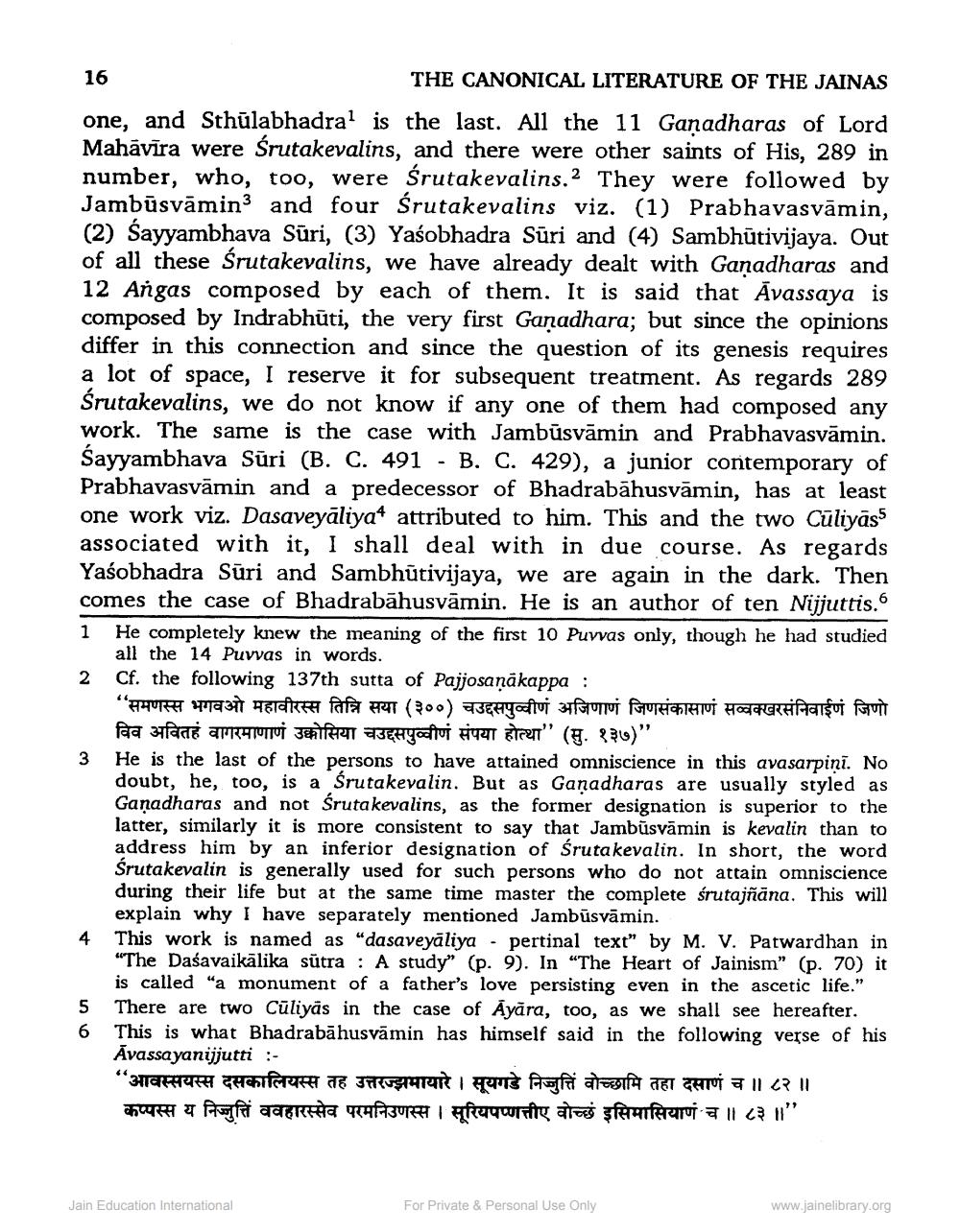________________
16
THE CANONICAL LITERATURE OF THE JAINAS one, and Sthūlabhadral is the last. All the 11 Ganadharas of Lord Mahāvīra were Śrutakevalins, and there were other saints of His, 289 in number, who, too, were Śrutakevalins.2 They were followed by Jambūsvāmin and four Śrutakevalins viz. (1) Prabhavasvāmin, (2) Sayyambhava Sūri, (3) Yaśobhadra Sūri and (4) Sambhūtivijaya. Out of all these Śrutakevalins, we have already dealt with Ganadharas and 12 Angas composed by each of them. It is said that Āvassaya is composed by Indrabhūti, the very first Ganadhara; but since the opinions differ in this connection and since the question of its genesis requires a lot of space, I reserve it for subsequent treatment. As regards 289 Śrutakevalins, we do not know if any one of them had com work. The same is the case with Jambūsvāmin and Prabhavasvāmin. Sayyambhava Süri (B. C. 491 - B. C. 429), a junior contemporary of Prabhavasvāmin and a predecessor of Bhadrabahusvāmin, has at least one work viz. Dasaveyāliyat attributed to him. This and the two Cūliyās associated with it, I shall deal with in due course. As regards Yaśobhadra Sūri and Sambhūtivijaya, we are again in the dark. Then comes the case of Bhadrabāhusvāmin. He is an author of ten Nijjuttis. 1 He completely knew the meaning of the first 10 Puvvas only, though he had studied
all the 14 Puvvas in words. 2 Cf. the following 137th sutta of Pajjosaņākappa :
"समणस्स भगवओ महावीरस्स तिनि सया (३००) चउद्दसपुव्वीणं अजिणाणं जिणसंकासाणं सव्वक्खरसंनिवाईणं जिणो
Para fans amR470T J ART 23hyoeftui 84T ETET" (. 836)" 3 He is the last of the persons to have attained omniscience in this avasarpiņi. No
doubt, he, too, is a Srutakevalin. But as Gañadharas are usually styled as Ganadharas and not śruta kevalins, as the former designation is superior to the latter, similarly it is more consistent to say that Jambusvāmin is kevalin than to address him by an inferior designation of śruta kevalin. In short, the word Śrutakevalin is generally used for such persons who do not attain omniscience during their life but at the same time master the complete śrutajñāna. This will explain why I have separately mentioned Jambūsvāmin. This work is named as "dasaveyaliya - pertinal text" by M. V. Patwardhan in "The Daśavaikālika sūtra: A study" (p. 9). In “The Heart of Jainism” (p. 70) it
is called "a monument of a father's love persisting even in the ascetic life." 5 There are two Cūliyās in the case of Ayara, too, as we shall see hereafter.
This is what Bhadrabāhusvāmin has himself said in the following verse of his Avassayanijjutti :"आवस्सयस्स दसकालियस्स तह उत्तरज्झमायारे । सूयगडे निजुत्तिं वोच्छामि तहा दसाणं च ॥ ८२ ॥ कप्पस्स य निज्जुत्तिं ववहारस्सेव परमनिउणस्स । सूरियपप्णत्तीए वोच्छं इसिमासियाणं च ।। ८३ ॥"
Jain Education International
For Private & Personal Use Only
www.jainelibrary.org




